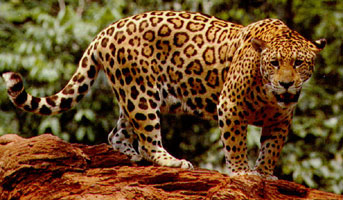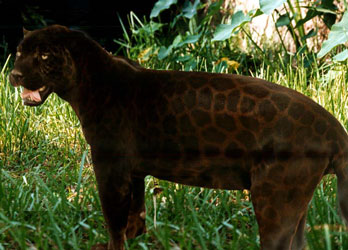This is the first entry in a series on words that begin with the letter J.
Jaguars!

Jaguar -- Panthera onca
(Photo from the Discovery Channel)

Places where jaguars live are shown in yellow.
(Distribution map from National Geographic)

Jaguar catching fish.
(Photo from Bluelion.org)

Here you can clearly see the rosette shape -- almost circles with a dot in the middle. Not every jaguar's spots form such an obvious pattern as this, but they do all generally make that circular shape, especially on the cat's flank.
(Photo from Big Cat Rescue)

This jaguar's fur is nearly black, though you can still make out a few spots.
(Photo from Big Cat Rescue)
Sources
Defenders of Wildlife, Jaguar (Panthera onca)
National Geographic, Jaguar (Panthera onca)
Indian Tiger, Jaguar
Big Cat Rescue, Jaguar
Jaguars!
Jaguar -- Panthera onca
(Photo from the Discovery Channel)
- Some jaguars live in the United States. I am completely surprised to learn this. I had thought they lived in Africa or someplace exotic.
- In the U.S., they live in Arizona, New Mexico, and Texas.
- However, they are endangered and extremely rare, so you don't typically see them wandering around the streets of Flagstaff.
- Outside the U.S. they live in Mexico as far south as Patagonia. Mainly they live in the northern part of South America, especially around the Amazon River basin.

Places where jaguars live are shown in yellow.
(Distribution map from National Geographic)
- They like a lot of different environments, including forests, jungles, grasslands, and mountainous regions with scrubby bushes.
- They like to eat a lot of things:
- deer
- monkeys
- crocodiles
- horses
- cattle
- snakes
- sloths
- tapirs
- capybaras
- peccaries (a.k.a. javelinas)
- ground-dwelling birds
- turtles
- eggs
- frogs
- fish
- They like water. They'll bathe in rivers and pools, playing around. They also hunt fish in the water. Slashola!

Jaguar catching fish.
(Photo from Bluelion.org)
- They also like to climb trees.
- They generally live and hunt individually. They do come out during the daytime, but really they prefer dawn and dusk. Which makes them another crepuscular animal. Thanks for that word, Meghan!
- Often they kill their prey by crushing the skull with one bite of their powerful jaws.
- The word "jaguar" comes from a Native American word yaguar which means "he who kills with one leap."
- The jaguar is the third largest species of cat after the lion and the tiger.
- Jaguar spots are considered distinctive and are generally described as being "rosette"-shaped.

Here you can clearly see the rosette shape -- almost circles with a dot in the middle. Not every jaguar's spots form such an obvious pattern as this, but they do all generally make that circular shape, especially on the cat's flank.
(Photo from Big Cat Rescue)

This jaguar's fur is nearly black, though you can still make out a few spots.
(Photo from Big Cat Rescue)
- Sometimes their spots are so close together their fur is almost black.
- Unlike the big cats, jaguars don't roar. They make a kind of chesty cough.
- I suspect this is the prusten, which you may have encountered in The Life of Pi, or the book on which its plot was shamelessly based, Max and the Cats. In that book, the big cat in the boat is a jaguar, not a tiger, and how it came to be there is more plausible than the explanation in The Life of Pi.
- There are many stories of jaguars stalking people for miles through the forest. Researchers think that the cats are actually "escorting" the people out of their territory.
- The Maya believed that the jaguar was the sun's bodyguard, escorting it as it traveled under the earth at night and ensuring it would rise safely the next morning.
Sources
Defenders of Wildlife, Jaguar (Panthera onca)
National Geographic, Jaguar (Panthera onca)
Indian Tiger, Jaguar
Big Cat Rescue, Jaguar
Excellent post!
ReplyDelete